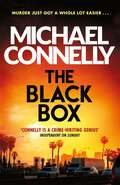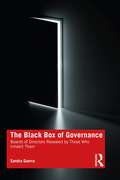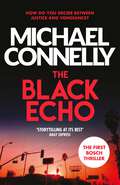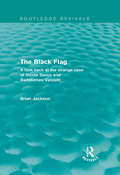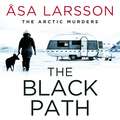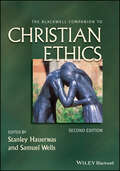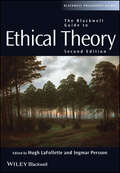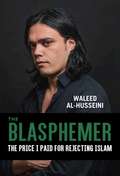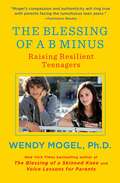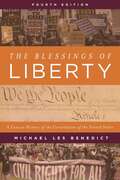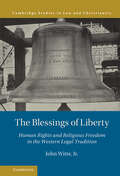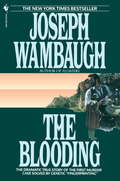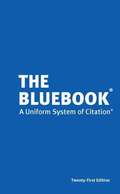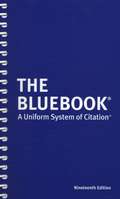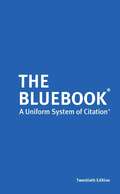- Table View
- List View
The Black Box (Harry Bosch Series #16)
by Michael ConnellyMay 1992, and after four LAPD officers are acquitted following the savage beating of Rodney King, Los Angeles is ablaze. As looting and burning take over the city, law and order are swept away in a tidal wave of violence. But under threat of their lives, homicide detectives like Harry Bosch are still stubbornly trying to do their job. With no effective police presence on the streets, murder just got a whole lot easier - and investigating them a whole lot harder. When Harry finds the body of a female journalist in an alley, he is forced to hand over the case to the Riot Crimes Task Force, knowing that it will never be solved.Twenty years later, new evidence confirms her death was not a case of random violence but something much more personal. This time Harry is determined that the killer isn't going to escape - even if it means stepping back into the darkest days of the city he loves . . .
The Black Box of Governance: Boards of Directors Revealed by Those Who Inhabit Them
by Sandra GuerraIn the world of corporate governance, the board of directors is often viewed as the "black box" of companies: only the board members who are seated at the meeting table understand how this "decision-making machine" works. In this book, a board member with over 25 years’ experience pulls off the lid and shows both how boards have worked and how they could work. This book is grounded in extensive research in three different surveys: one with more than 100 Brazilian directors, another with 340 board members from 40 countries, and a final one with 103 Brazilian directors serving on 238 boards. It also includes interviews with Ira Millstein, Sir Adrian Cadbury, Robert Monks and Mervyn King. The inner-workings of the board of directors are revealed: • What keeps directors awake at night • Obstacles to efficient decision-making • Behavioral dynamics, both within the board and in relation to the management • Pitfalls that arise from individual and group biases Based on these insights and the author’s own consulting and board experience, the book presents a guide to behavioral tools enabling directors and executives to confidently navigate the boardroom, improving interactivity and the efficiency of the decision-making process. Intended for directors and executives who are directly involved in the board's activities, as well as for leaders responsible for strategy implementation, this book provides a behavioral compass for all those interacting with the "black box."
The Black Child-Savers: Racial Democracy and Juvenile Justice
by Geoff K. WardDuring the Progressive Era, a rehabilitative agenda took hold of American juvenile justice, materializing as a citizen-and-state-building project and mirroring the unequal racial politics of American democracy itself. Alongside this liberal "manufactory of citizens," a parallel structure was enacted: a Jim Crow juvenile justice system that endured across the nation for most of the twentieth century. In The Black Child Savers, the first study of the rise and fall of Jim Crow juvenile justice, Geoff Ward examines the origins and organization of this separate and unequal juvenile justice system. Ward explores how generations of "black child-savers" mobilized to challenge the threat to black youth and community interests and how this struggle grew aligned with a wider civil rights movement, eventually forcing the formal integration of American juvenile justice. Ward's book reveals nearly a century of struggle to build a more democratic model of juvenile justice--an effort that succeeded in part, but ultimately failed to deliver black youth and community to liberal rehabilitative ideals. At once an inspiring story about the shifting boundaries of race, citizenship, and democracy in America and a crucial look at the nature of racial inequality, The Black Child Savers is a stirring account of the stakes and meaning of social justice.
The Black Echo (Harry Bosch Series #1)
by Michael ConnellyGo back to where it all began for LAPD detective Harry Bosch, star of Amazon Prime's Bosch, in his first case The Black Echo - a gripping, action-packed thriller.LAPD detective Harry Bosch is a loner and a nighthawk. One Sunday he gets a call-out on his pager. A body has been found in a drainage tunnel off Mulholland Drive, Hollywood. At first sight, it looks like a routine drugs overdose case, but the one new puncture wound amid the scars of old tracks leaves Bosch unconvinced.To make matters worse, Harry Bosch recognises the victim. Billy Meadows was a fellow 'tunnel rat' in Vietnam, running against the VC and the fear they all used to call the Black Echo. Bosch believes he let down Billy Meadows once before, so now he is determined to bring the killer to justice.
The Black Flag: A look back at the strange case of Nicola Sacco and Bartolomeo Vanzetti (Routledge Revivals)
by Brian JacksonFirst published in 1981, this book reassesses the case of Sacco and Vanzetti, two Italian immigrant anarchists living in Boston in 1920. The pair were accused of a payroll robbery and the murder of two guards for which they were arrested and, after a long trial based on inadequate and prejudiced evidence, executed in 1927. In 1977, on the fiftieth anniversary of their deaths, the Commonwealth of Massachusettes issued a proclamation which acknowledged a miscarriage of justice. The Black Flag provides an account of the controversial trial and a re-evaluation of the celebrated case of the Commonwealth’s decision. Brian Jackson puts the trial in the social context of the period and exposes the nature of anarchism by looking at the lives of two of its exponents, resulting in a moving exploration of a series of events that continue to trouble the conscience of America.
The Black Ice (Harry Bosch Series #2)
by Michael ConnellyWhen a body is found in a hotel room, reporters are soon all over the case: it appears to be a missing LAPD narcotics detective, apparently gone to the bad. The rumours were that he had been selling a new drug called Black Ice that had been infiltrating Los Angeles from the Mexican cartel. The LAPD are quick to declare the death a suicide, but Harry Bosch is not so sure. There are odd mysteries and unexplained details from the crime scene which just don't add up. Fighting an attraction to the detective's widow, Bosch starts his own maverick investigation, which soon leads him over the borders and into a dangerous world of shifting identities, police politics and deadly corruption . . .
The Black Path: Rebecka Martinsson: Arctic Murders – Now a Major TV Series
by Åsa LarssonThe novels that inspired Rebecka Martinsson: Arctic Murders - the major TV seriesOne of The Times' "Best Crime Novels by Women since 2000" "Rebecka Martinsson: the new Scandi-noir heroine to rival Saga Noren and Sarah Lund" iNews "In a television world now awash in female coppers, there aren't many as interesting and human as Rebecka" Wall Street JournalThe frozen body of a woman is found in a fishing ark on the ice near Torneträsk in northern Sweden. She has been brutally tortured, but the killing blow was clumsy, almost amateur. The body is quickly identified, raising hopes of an open-and-shut solution. But when a six-month-old suicide is disinterred, Rebecka Martinsson and Anna-Maria Mella find themselves investigating shocking corruption at the heart of one of Sweden's most successful mining companies. One that has powerful enemies of its own.
The Black Path: Rebecka Martinsson: Arctic Murders – Now a Major TV Series (The Arctic Murders)
by Åsa LarssonThe novels that inspired Rebecka Martinsson: Arctic Murders - the major TV series One of The Times' "Best Crime Novels by Women since 2000" "Rebecka Martinsson: the new Scandi-noir heroine to rival Saga Noren and Sarah Lund" iNews "In a television world now awash in female coppers, there aren't many as interesting and human as Rebecka" Wall Street JournalThe frozen body of a woman is found in a fishing ark on the ice near Torneträsk in northern Sweden. She has been brutally tortured, but the killing blow was clumsy, almost amateur. The body is quickly identified, raising hopes of an open-and-shut solution. But when a six-month-old suicide is disinterred, Rebecka Martinsson and Anna-Maria Mella find themselves investigating shocking corruption at the heart of one of Sweden's most successful mining companies. One that has powerful enemies of its own.
The Black Path: The Arctic Murders – A gripping and atmospheric murder mystery (The Arctic Murders #1)
by Åsa LarssonA woman's body is found on a frozen lake, bearing the marks of grisly torture. Inspector Anna-Maria Mella knows she needs help with the case - the woman was a key player in a mining company whose tentacles reach across the globe. Lawyer Rebecka Martinsson is desperate to get back to work, to feel alive again after a case that almost destroyed her both physically and emotionally. Soon she is delving into the affairs of the victim's boss, the founder of Kallis Mining, whose relationship with the dead woman was complex and obsessive. Martinsson and Mella are about to uncover a dark and tangled drama of family secrets, twisted sexuality, and corruption on a massive scale. Set against a haunting, icy backdrop and packed with suspense, The Black Path is a menacing and evocative psychological crime novel.(P)2014 WF Howes Ltd
The Black and the Blue: A Cop Reveals the Crimes, Racism, and Injustice in America's Law Enforcement
by Matthew Horace Ron HarrisCNN contributor offers a searing indictment of America's law enforcement."This is a must-read.... Telling this story demonstrates nothing but raw courage for a black police officer who wants the truth to prevail." --John Lewis"[T]his [is a] hard-hitting, convincing indictment of the biases in today's law enforcement.... A must-read for anyone interested in understanding and solving these problems." --Booklist (starred review)Matthew Horace was an officer at the federal, state, and local level for 28 years working in every state in the country. Yet it was after seven years of service when Horace found himself face-down on the ground with a gun pointed at his head by a white fellow officer, that he fully understood the racism seething within America's police departments. Using gut-wrenching reportage, on-the-ground research, and personal accounts garnered by interviews with police and government officials around the country, Horace presents an insider's examination of police tactics, which he concludes is an "archaic system" built on "toxic brotherhood." Horace dissects some of the nation's most highly publicized police shootings and communities highlighted in the Black Lives Matter movement and beyond to explain how these systems and tactics have had detrimental outcomes to the people they serve. Horace provides fresh analysis on communities experiencing the high killing and imprisonment rates due to racist policing such as Ferguson, New Orleans, Baltimore, and Chicago from a law enforcement point of view and uncovers what has sown the seeds of violence.Timely and provocative, The Black and The Blue sheds light on what truly goes on behind the blue line.
The Blackwell Companion to Christian Ethics
by Stanley Hauerwas Samuel WellsFeaturing updates, revisions, and new essays from various scholars within the Christian tradition, The Blackwell Companion to Christian Ethics, Second Edition reveals how Christian worship is the force that shapes the moral life of Christians.Features new essays on class, race, disability, gender, peace, and the virtuesIncludes a number of revised essays and a range of new authorsThe innovative and influential approach organizes ethical themes around the shape of Christian worshipThe original edition is the most successful to-date in the Companions to Religion series
The Blackwell Guide to Ethical Theory
by Hugh Lafollette Ingmar PerssonBuilding on the strengths of the highly successful first edition, the extensively updated Blackwell Guide to Ethical Theory presents a complete state-of-the-art survey, written by an international team of leading moral philosophers. A new edition of this successful and highly regarded Guide, now reorganized and updated with the addition of significant new materialIncludes 21 essays written by an international team of leading philosophersExtensive, substantive essays develop the main arguments of all the leading viewpoints in ethical theoryEssays new to this edition cover evolution and ethics, capability ethics, virtues and consequences, and the implausibility of virtue ethics
The Blasphemer: The Price I Paid for Rejecting Islam
by Waleed Al-HusseiniThe Infuriating Tale Of A Young Palestinian Punished For Exercising His Freedom Of Speech.Like many of his generation, Waleed Al-Husseini began a blog in his twenties. However, unlike many, Waleed also had the misfortune of having been a blogger in Palestine; worse yet, he often criticized Islam and its adherents-and declared himself an apostate-in his writings. The Palestinian Authority did not take well to this and eventually put Waleed in jail without a trial or even a wisp of legal justification. As if this was not bad enough, they placed Waleed in solitary confinement. This state of affairs continued for 11 months. Over the course of this time, Waleed was tortured and suffered innumerable indignities and deprivations simply for having the audacity to speak his mind. Eventually his unjust imprisonment began to draw international attention from foreign governments and human rights organizations, which pressured the Palestinian Authority and finally forced it to provide him a trial and parole. After being paroled, Waleed fled Palestine, first to Jordan and then to France, where he has become an outspoken advocate for freedom of speech and a critic of the state of contemporary Islam. The Blasphemer is a sobering, impassioned recounting of this Kafkaesque experience as well as a searing polemic against the corruption and hypocrisy that define contemporary Palestine.
The Blessing of a B Minus: Using Jewish Teachings to Raise Resilient Teenagers (Playaway Adult Nonfiction Ser.)
by Wendy MogelNew York Times bestselling author, internationally known clinical psychologist, and lecturer Wendy Mogel returns with a revelatory new book on parenting teenagers. Mogel's sage advice on parenting young children has struck a chord with thousands of readers and made her one of today's most trusted parenting authorities. Now, in a long-awaited follow-up, Mogel addresses the question she hears most frequently: what to do when those children become teenagers, when their sense of independence and entitlement grows, the pressure to compete and succeed skyrockets, and communication becomes fraught with obstacles? With her warmth, wit, and signature combination of Jewish teachings and psychological research, Mogel helps parents to ably navigate the often rough journey through the teenage years and guide children to becoming confident, resilient young adults. By viewing the frustrating and worrisome elements of adolescence as "blessings," Mogel reveals that they are in fact necessary steps in psychological growth and character development to be met with faith, detachment, and a sense of humor rather than over-involvement and anxiety. Mogel gives parents the tools to do so and offers reassuring spiritual and ethical advice on * why influence is more effective than control. * teenage narcissism. * living graciously with rudeness. * the value of ordinary work. * why risk is essential preparation for the post-high school years. * when to step in and when to step back. * a sanctified approach to sex and substances. An important and inspiring book that will fortify parents through the teenage years, The Blessing of a B Minus is itself a blessing.
The Blessings of Liberty: A Concise History of the Constitution of the United States
by Michael Les BenedictThis concise, accessible text provides students with a history of American constitutional development in the context of political, economic, and social change. Constitutional historian Michael Benedict stresses the role that the American people have played over time in defining the powers of government and the rights of individuals and minorities. He covers important trends and events in U.S. constitutional history, encompassing key Supreme Court and lower-court cases. The volume begins by discussing the English and colonial origins of American constitutionalism. Following an analysis of the American Revolution's meaning to constitutional history, the text traces the Constitution's evolution from the Early Republic to the present day. This fourth edition is updated to include the 2016 election, the Trump administration, the 2020 election, and the first activities of the Biden administration.
The Blessings of Liberty: Human Rights and Religious Freedom in the Western Legal Tradition (Law and Christianity)
by John Witte, Jr.Leading legal scholar John Witte, Jr. explores the role religion played in the development of rights in the Western legal tradition and traces the complex interplay between human rights and religious freedom norms in modern domestic and international law. He examines how US courts are moving towards greater religious freedom, while recent decisions of the pan-European courts in Strasbourg and Luxembourg have harmed new religious minorities and threatened old religious traditions in Europe. Witte argues that the robust promotion and protection of religious freedom is the best way to protect many other fundamental rights today, even though religious freedom and other fundamental rights sometimes clash and need judicious balancing. He also responds to various modern critics who see human rights as a betrayal of Christianity and religious freedom as a betrayal of human rights.
The Blockchain and the New Architecture of Trust (Information Policy)
by Kevin WerbachHow the blockchain—a system built on foundations of mutual mistrust—can become trustworthy.The blockchain entered the world on January 3, 2009, introducing an innovative new trust architecture: an environment in which users trust a system—for example, a shared ledger of information—without necessarily trusting any of its components. The cryptocurrency Bitcoin is the most famous implementation of the blockchain, but hundreds of other companies have been founded and billions of dollars invested in similar applications since Bitcoin's launch. Some see the blockchain as offering more opportunities for criminal behavior than benefits to society. In this book, Kevin Werbach shows how a technology resting on foundations of mutual mistrust can become trustworthy. The blockchain, built on open software and decentralized foundations that allow anyone to participate, seems like a threat to any form of regulation. In fact, Werbach argues, law and the blockchain need each other. Blockchain systems that ignore law and governance are likely to fail, or to become outlaw technologies irrelevant to the mainstream economy. That, Werbach cautions, would be a tragic waste of potential. If, however, we recognize the blockchain as a kind of legal technology that shapes behavior in new ways, it can be harnessed to create tremendous business and social value.
The Blooding
by Joseph WambaughFor the first time, Joseph Wambaugh turns his attention outside the United States to deal with two murders in neighboring English Midlands villages-ancient villages that still have whitewashed Tudor cottages, pavements too narrow for passing baby prams, streets barely wide enough for two cars, and churches or pubs as the sites of community life. What intrigues the master of true-crime writing is that out of the sleepy setting grew a landmark case: the first murders solved by genetic fingerprinting. The victims of the terrifying rape-murders -two fifteen-year-old girls who do not know each other-have in common one fatal mistake: they choose to walk village footpaths bordering the lands of a psychiatric hospital. Forever after, the names Ten Pound Lane and The Black Pad will evoke fear and dread. The murders occur three years apart, and during all those years the members of the Leicestershire constabulary never give up their search. The local newspapers cooperate by keeping the cases alive. And the families of the victims try to cope with the chaos of their existence.
The Blooding
by Joseph WambaughFifteen-year-old Lynda Mann's savagely raped and strangled body is found along a shady footpath near the English village of Narborough. Though a massive 150-man dragnet is launched, the case remains unsolved. Three years later the killer strikes again, raping and strangling teenager Dawn Ashforth only a stone's throw from where Lynda was so brutally murdered. But it will take four years, a scientific breakthrough, the largest manhunt in British crime annals, and the blooding of more than four thousand men before the real killer is found.
The Bloody Code in England and Wales, 1760–1830 (World Histories of Crime, Culture and Violence)
by John WallissThis book is a comparative quantitative analysis of the administration of justice across four English and three Welsh counties between 1760 and 1830. Drawing on a dataset of over 22,000 indictments, the book explores the similarities and differences between how the so-called Bloody Code was administered between, on the one hand, England and Wales, and, on the other, individual English and Welsh counties. The book is structured in two sections that trace the criminal justice process in England and Wales respectively. The first chapter in each section examines the pattern of indictments in the respective counties, and explores the crimes for which men and women were indicted, the verdicts handed down, and the sentences passed. The second chapter then explores patterns of sentences of death, executions and pardons for those capitally convicted of serious crimes against the person and forms of property offences.
The Bluebook (Twenty-First Edition): A Uniform System Of Citation
by The Harvard Law Review AssociationThe Twenty-First Edition of The Bluebook: A Uniform System of Citation, a definitive guide for legal citation in the United States, compiled by the editors of the Columbia Law Review, Harvard Law Review, University of Pennsylvania Law Review, and Yale Law Journal. It provides a standardized system of citation used by law students, lawyers, scholars, judges, and other legal professionals. The Bluebook is divided into three parts: the Bluepages, which serve as a basic guide for legal citation; the Whitepages, which contain detailed rules for citation and style; and a series of tables to be used in conjunction with the rules. The document highlights changes in citation rules, offers guidance on citing various legal authorities, and includes updates for modern legal practices. The edition emphasizes practicality, ease of use, and the importance of accurate citation to facilitate the efficient location of legal sources.
The Bluebook: A Uniform System Of Citation, 19th edition
by Columbia Law ReviewGenerations of law students, lawyers, scholars, judges, and other legal professionals have relied on The Bluebook's unique system of citation in their writing. In a diverse and rapidly changing legal profession, The Bluebook continues to provide a systematic method by which members of the profession communicate important information to one another about the sources and legal authorities upon which they rely in their work.
The Bluebook: A Uniform System of Citation
by the Harvard Law Review the University of Pennsylvania Law Review Editors of the Columbia Law Review and The Yale Law JournalThe Bluebook provides the comprehensive, standardized citation system for the legal profession in the United States. This edition of The Bluebook retains the same basic approach to legal citation established by its predecessors. Some citation forms have been expanded, reduced, or modified from previous editions. This edition focuses on making The Bluebook more practical for modern legal practice.
The Bluebook: A Uniform System of Citation (Eighteenth Edition)
by Columbia Law Review Harvard Law Review University of Pennsylvania Law Review Yale Law JournalThis edition of The Bluebook retains the same basic approach to legal citation established by its predecessors. The Bluepages, new to the Eighteenth Edition, is a how-to guide providing easy-to-comprehend instruction for the everyday citation needs of first-year law students, summer associates, law clerks, practicing lawyers, and other legal professionals.
The Bluebook: A Uniform System of Citation (Twentieth Edition)
by the editors of the Columbia Law Review the Harvard Law Review the University of Pennsylvania Law Review The Yale Law JournalThe Bluebook: A Uniform System of Citation, is a style guide that prescribes the most widely used legal citation system in the United States.
